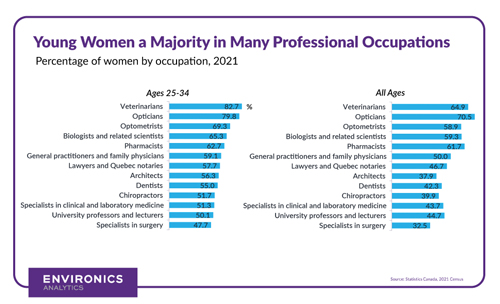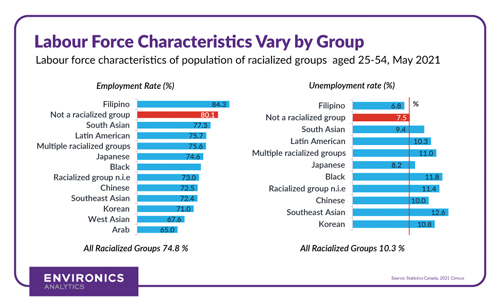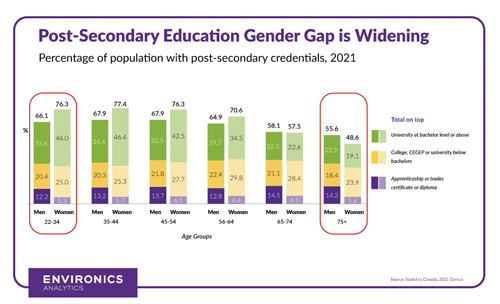 By Dr. Doug Norris, PhD
By Dr. Doug Norris, PhD
When the seventh and final wave of data from the 2021 Census was released by Statistics Canada, it covered the two main topics of education levels and the labour force. This release also includes data on place of work, commuting patterns and languages spoken at work.
Education levels continue to rise, especially for women
Newly released data shows that 67.1 percent of the population aged 25-64 now have a post-secondary degree or diploma compared to 64.8 percent in 2016 and 60.7 percent in 2006.
In 2021, 70 percent of women aged 25-64 had a post-secondary degree or diploma compared to 64.8 percent in 2006. Proportionally fewer men had higher education degrees (64.2 percent) and a smaller increase from 60.9 percent in 2006.
The gender education gap is much more pronounced when you focus on the younger population between the ages 25 and 34. Within this cohort, 76.3 percent of women had a post-secondary degree or diploma, compared with 66.1 percent of men. It’s worth noting that except for the trades, young women aged 25-34 are also a majority of degree holders at all levels, including the earned doctorate.
Stacked bar graphs showing the percentage of men and women in the Canadian population with post-secondary credentials based on the 2021 Census.
 Pictured above: stacked bar graphs showing the percentage of men and women in the Canadian population with post-secondary credentials based on the 2021 Census.
Pictured above: stacked bar graphs showing the percentage of men and women in the Canadian population with post-secondary credentials based on the 2021 Census.
Despite the overall increase in education levels, the number of adults with an apprenticeship certificate in the skilled trades decreased from 12.4 percent in 2006 to 10.8 percent in 2016 and to 9.9 percent in 2021. This is a result of fewer young workers replacing retiring baby boomers and contributes to a shortage of workers in some key trades.
And while you will find more women on university campuses, this trend hasn’t found its way to trade schools. Over 80 percent of all apprentice certificates among persons 25-34 are held by men, and the percent of women with an apprenticeship certificate declined slightly from 1.6 percent in 2016 to 1.3 percent in 2021.
The most popular fields of study for young women aged 25 to 34 were health professions and related programs (20.5 percent), business, management, marketing and related support services (19.6 per-cent), followed by education (6.5 percent) and social sciences (4.8 percent). As for males, the most popular fields of study were business, management, marketing and related support services (18.5 per-cent), engineering (10.6 percent), construction trades (8.5 percent) and computer and information sciences and support services (6.6 percent).
By 2021 employment was nearly back to levels in 2016
In the 2021 Census, Canada’s employment numbered 19.3 million, down slightly from 19.5 million in 2016, likely as a result of the pandemic. The overall employment rate in May 2021 was 57.1 percent, also down slightly from five years earlier. The employment rate was 60.9 percent for men and 53.4 percent for women.
According to the monthly Labour Force Survey, employment in 2021 was up from the pre-pandemic lows in April 2020 and numbers have been slowing increasing since the Census was taken in May 2021.
According to the Census, in May 2021 the unemployment rate was 10.3 percent compared to 7.0 percent in the May 2016 Census. The Labour Force Survey reported the unemployment rate hit a high of 13.8 percent in May 2020, one year before the census. Since the 2021 Census, the unemployment rate gradually declined and reached a near all-time low 5.2 percent in October 2022.
Employment growth was strongest in the service producing industries
From 2016 to 2021, employment gains were highest in professional, scientific and technical services (up 18 percent), health care and social assistance (14 percent) and construction (7.6 percent). At the time of the Census in May 2021, employment in the accommodation and food services industries had not fully recovered from the pandemic lows and was 16 percent lower than in 2016. However, in the last 18 months since the Census was taken employment continued to grow.
Women gain in many professional occupations, but large numbers are in low paying jobs. Young women are now a majority and women are getting close to a majority overall in many professional occupations.
 Pictured above: bar chart showing the percentage of women by occupation, ages 25 – 34 vs. all ages, according to the 2021 Census.
Pictured above: bar chart showing the percentage of women by occupation, ages 25 – 34 vs. all ages, according to the 2021 Census.
In 2021, the top jobs for women were retail salespersons and visual merchandisers (342,000), nurse aides, orderlies and patient service associates (299,000), registered nurses and registered psychiatric nurses (294,000), cashiers (280,000), and food counter attendants and kitchen helpers (251,000).
For men, the top jobs were transport truck drivers (356,000), retail salespersons and visual merchandisers (290,000), retail and wholesale trade managers (231,000), construction trades helpers and labourers (199,000) and material handlers (185,000).
Higher education pays off
Employment and unemployment rates varied by the highest level of education. For the working age group 25 to 64, the employment rate was close to 79.4 percent and the unemployment rate was 7.1 percent for those with a post-secondary degree or diploma, compared to 65.8 percent and 11.5 percent for those with only a high school diploma and 51.1 percent and 15.1 percent for those who did not complete high school.
The median annual earnings for persons working full time-full year with a bachelor’s degree was $77,500 compared to those with a college degree ($60,800) and those with only a high school diploma ($51,200). However, it is noteworthy that those with an apprenticeship certificate of qualification in the trades had strong earnings. Their median annual earnings in 2020 ($70,000) were 15 percent more than those with a college diploma, 37 percent more than those with a high school diploma, but 11 percent less than those with a bachelor’s degree.
Immigrants are highly educated but have lower employment rates and higher unemployment rates
In 2021, 49 percent of immigrants aged 25-54 had a bachelor’s degree or higher compared to 30 percent of the Canadian-born population. The proportion was even higher for recent immigrants (61 percent).
In May 2021, the employment rate for immigrants aged 25-54 was 82 percent compared to 89 percent for the Canadian-born population. The unemployment rate was 7.7 percent for immigrants compared to 4.2 percent for their Canadian born counterparts. The employment rate generally increased and the unemployment rate decreased the longer immigrants had been in Canada. For example, the unemployment rate for recent immigrants was 9.7 percent more than double the rate for immigrants before 1980.
Wide variation in labour force characteristics among racialized population groups
There are wide variations in terms of employment and unemployment across the various racialized groups. Overall, the employment rate for the racialized population aged 25-54 was 75 percent compared to 80 percent for the non-racialized population. The unemployment rate for the racialized population was 10.3 percent compared to 7.5 percent for the non-racialized population.
 Pictured above: bar chart showing the employment rate and unemployment rate among racialized groups of the Canadian population according to the 2021 Census.
Pictured above: bar chart showing the employment rate and unemployment rate among racialized groups of the Canadian population according to the 2021 Census.
The population in racialized groups account for 27 percent of the labour force but had higher representation in certain types of occupations. In particular, they accounted for 40 percent of the work-force in STEM occupations (science, technology, engineering and mathematics). They also account for 37 percent of health occupations and 36 percent of occupations in manufacturing and utilities.
Education levels are up for Indigenous People but gaps remain
Overall, in 2021, 74 percent of Indigenous persons aged 25-64 had completed high school compared to 89 percent of non-indigenous persons. The rates were 78 percent for the indigenous population living off-reserves but only 55 percent for the on-reserve population. Nearly half of Indigenous persons had a post-secondary degree or diploma—52 percent off reserve and 32 percent on reserve, compared to 68 percent of the non-indigenous population.
In 2021, the labour force participation rate for the Indigenous population aged 25-64 was 70.6 percent compared to 81 percent for the non-Indigenous population. The rate for the off-reserve Indigenous population was 73.3 percent compared to a rate of 56.5 percent for the on-reserve population. The unemployment rate was 16.4 percent for the Indigenous population on reserve and 12.7 percent for the Indigenous population off reserve, compared with an unemployment rate of 8.4 percent for the non-indigenous population.
Implications for businesses and marketers
The rising education levels revealed in this Census release is a trend marketers will need to watch. For starters, it means marketers need to fact-check their statements as Canadians will be better equipped than ever to evaluate product claims and select the best value for them and their families.
Well-educated young women will need to be a particular focus of marketers. As these women begin their professional careers and families, they will no doubt demand products and services that reflect their more independent and sophisticated lifestyle. And they will be looking for help in juggling their shopping as part of a busy schedule.
With the low growth in the labour force population, immigrants and the Indigenous population will continue to be important sources of labour supply for all organizations. Public- and private-sector employers need to reach out to Indigenous youth to help them gain the education and training required to become members of tomorrow’s workforce. In the case of highly-skilled immigrants, more needs to be done to get quicker approval of credentials.
Over the next decade, the population of young adults between 20 and 29 years old—an important source of entry level labour force—will decline. Organizations will need to look for new ways to attract this young workforce for their job openings.
Doug Norris, PhD is Senior Vice President and Chief Demographer at Environics Analytics.




